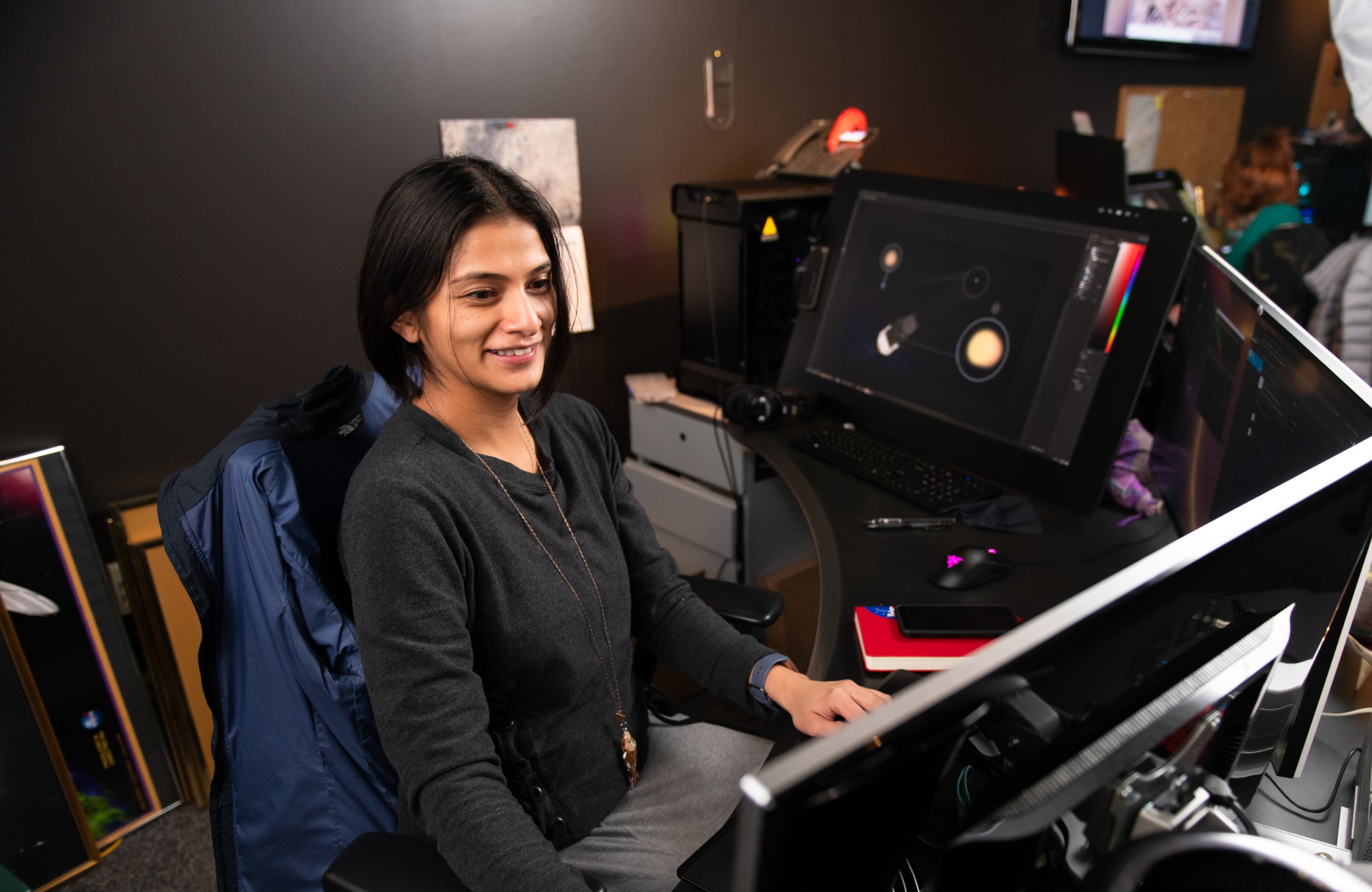
Name: Adriana Manrique Gutierrez
Title: Animator
Formal Job Classification: Multimedia Specialist, Animator
Organization: Code 130, Conceptual Image Lab
What do you do and what is most interesting about your role here at Goddard?
My role here is to create multimedia products for outreach, education and to use in the scientific community. What I create spans all the way from very technical, products that are mostly aimed to an audience of scientists and engineers, to something that is appealing and understandable for little kids. What I do is kind of like a translator who takes all the science and engineering and crunches it down to a finished product that is easy to digest, approachable and relatable for everyone. My role is to reach to those people who may not be originally interested through graphics and videos.
Tell us about you background in art.
I started by working with illustrator at the Savannah College of Art and Design, SCAD, down in Savannah, Georgia. I got my bachelor’s degree in illustration, along with a bachelor’s degree in animation. Then I worked as a freelancer for a little bit, then went back to SCAD, and got my master’s degree in animation. During my master’s is when I began working with the ICESat-2 mission.
The ICESat-2 mission, or Ice, Cloud and Land Elevation Satellite 2, was launched Sept. 15, 2018. The mission was to measure the changes in elevation through time in the cryosphere, which is Earth’s frozen and icy areas. It also set out to measure the elevations of ice sheets, glaciers and sea ice. The satellite carries a photon-counting laser, that pulses 10,000 times a second shooting billions of photons but only a dozen come back. It is the speed at which they come back that measures the elevation.
What got you interested in animation?
A friend told me to try just one animation class, while at SCAD, just to take as an elective. I tried it and I thought it was a pretty cool experience. Instead of having one static image from illustration, I can actually move it to tell a more complete story.
How did you end up here at Goddard?
There’s a program at SCAD that’s called SCADpro, formerly Collaborative Learning Center. The program has companies come in and ask students to help with their special projects. That’s how I got introduced to ICESat-2. They came in and wanted us to do something that no mission had done before. So a team of 12 other students and I created multiple proposals for everything: website redesign, apps, printout posters, brochures, animation, comic books, characters and mascots. ICESat-2 then decided what they wanted, and my team started development on those ideas. After that, they came back to us to produce a short film, called Photon Jump. The team for the short film was smaller, but everyone was a specialist in their field, so it was a pretty strong team. After creating that film, I kept freelancing for them, and then at one point they asked if I wanted to work at Goddard, an offer that I accepted.
How does it feel to produce work that is viewed and enjoyed by so many people?
It’s pretty amazing, because sometimes you see it in places you would not expect at all. It’s cool when a friend sends me a note saying that they saw my stuff in places like the New York Times. It’s just incredible to reach that many people.
How did you come up with the idea to illustrate the work of the ICESat-2 mission with a playful photon character?
They wanted to reach the people who would not have originally been interested all the technical parts of the mission. The way the scientists, Thorsten Markus, Tony Martino and Thomas Neumann, explained the journey of the photon from the ATLAS instrument, down to the surface of the Earth and back up to ICESat-2. We thought of the photon like it was a brave little guy, that goes down with billions of friends and one comes back. The team just thought that it was the perfect little hero story, so when we were developing for the mission, we decided to go with that idea.
What is something you wished you knew on your first day?
Working for such a variety of fields, from engineering, heliophysics, the study of the Sun and how the Sun physically interacts with the solar system, astrophysics, planetary science and Earth sciences, I wish I had a bit more background in those fields.
What is the most challenging project you have worked on while here?
While here, I think it would be working on the James Webb Space Telescope projects. Mainly because the science was completely new to me. It involved a lot of research and development, as well as learning new techniques. I had to go really in depth into that project, so it was pretty challenging.
The Webb telescope, about the size of a tennis court, is an international collaboration that is scheduled to launch in 2021 to study every phase in the history of the universe. This entails the first glows after the big bang, the formation of solar systems that might be capable of supporting life like Earth and the evolution of our own solar system.
What is your “six-word memoir”? A six-word memoir describes someone in just six words.
I love and enjoy a challenge.
By Ellie Ford
NASA Goddard Space Flight Center

























